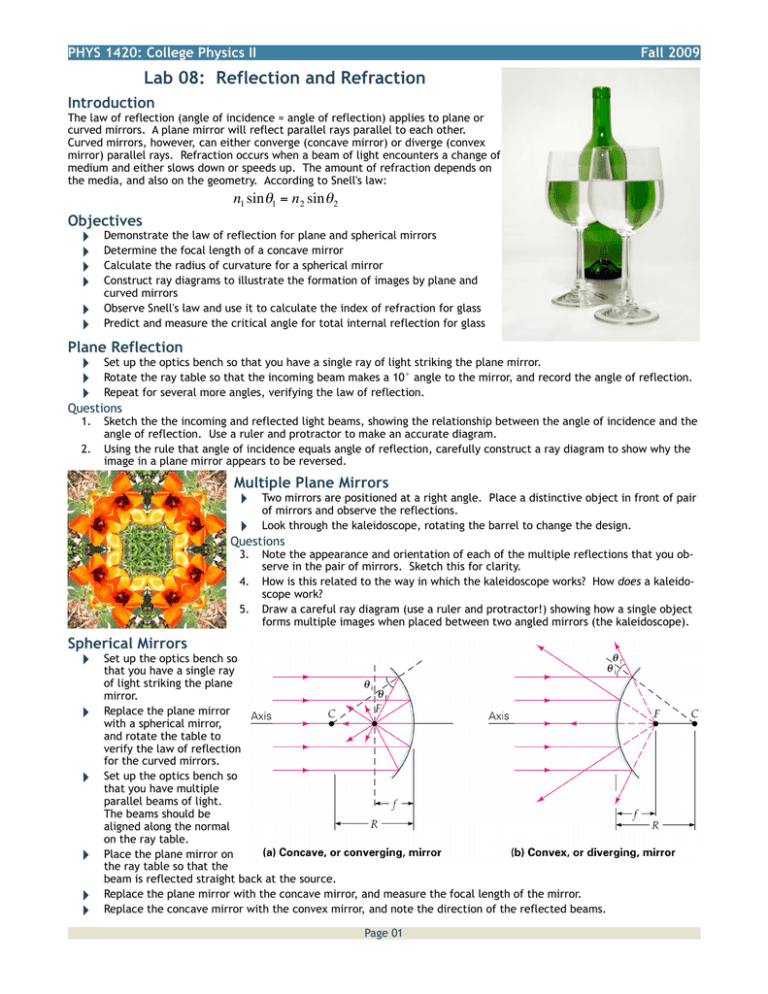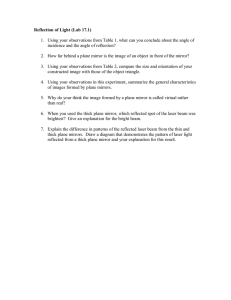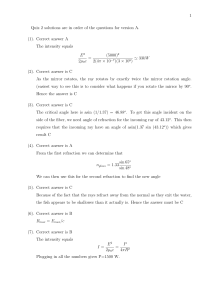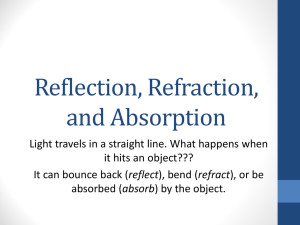Lab 08: Reflection and Refraction
advertisement

PHYS 1420: College Physics II Fall 2009 Lab 08: Reflection and Refraction Introduction The law of reflection (angle of incidence = angle of reflection) applies to plane or curved mirrors. A plane mirror will reflect parallel rays parallel to each other. Curved mirrors, however, can either converge (concave mirror) or diverge (convex mirror) parallel rays. Refraction occurs when a beam of light encounters a change of medium and either slows down or speeds up. The amount of refraction depends on the media, and also on the geometry. According to Snell's law: n1 sin θ1 = n 2 sin θ 2 Objectives ‣ ‣ ‣ ‣ ‣ ‣ Demonstrate the law of reflection for plane and spherical mirrors Determine the focal length of a concave mirror Calculate the€ radius of curvature for a spherical mirror Construct ray diagrams to illustrate the formation of images by plane and curved mirrors Observe Snell's law and use it to calculate the index of refraction for glass Predict and measure the critical angle for total internal reflection for glass Plane Reflection ‣ ‣ ‣ Set up the optics bench so that you have a single ray of light striking the plane mirror. Rotate the ray table so that the incoming beam makes a 10° angle to the mirror, and record the angle of reflection. Repeat for several more angles, verifying the law of reflection. 1. Sketch the the incoming and reflected light beams, showing the relationship between the angle of incidence and the angle of reflection. Use a ruler and protractor to make an accurate diagram. Using the rule that angle of incidence equals angle of reflection, carefully construct a ray diagram to show why the image in a plane mirror appears to be reversed. Questions 2. Multiple Plane Mirrors ‣ ‣ Two mirrors are positioned at a right angle. Place a distinctive object in front of pair of mirrors and observe the reflections. Look through the kaleidoscope, rotating the barrel to change the design. 3. Note the appearance and orientation of each of the multiple reflections that you observe in the pair of mirrors. Sketch this for clarity. How is this related to the way in which the kaleidoscope works? How does a kaleidoscope work? Draw a careful ray diagram (use a ruler and protractor!) showing how a single object forms multiple images when placed between two angled mirrors (the kaleidoscope). Questions 4. 5. Spherical Mirrors ‣ ‣ ‣ ‣ ‣ ‣ Set up the optics bench so that you have a single ray of light striking the plane mirror. Replace the plane mirror with a spherical mirror, and rotate the table to verify the law of reflection for the curved mirrors. Set up the optics bench so that you have multiple parallel beams of light. The beams should be aligned along the normal on the ray table. Place the plane mirror on the ray table so that the beam is reflected straight back at the source. Replace the plane mirror with the concave mirror, and measure the focal length of the mirror. Replace the concave mirror with the convex mirror, and note the direction of the reflected beams. Page 01 PHYS 1420: College Physics II Fall 2009 Questions 6. 7. 8. Use the ruler and protractor to make an accurate sketch of the incoming and reflected beams for each of the curved mirrors. Make sure to sketch the difference between concave and convex mirrors. What is the focal length of the spherical converging (concave) mirror? Calculate the radius of curvature. What are the focal length and radius of curvature for the diverging (convex) mirror? UFO Mirror ‣ ‣ ‣ Examine the curved dish containing the pennies. Replace the pennies with different small, three-dimensional objects. Notice the orientation of the image with respect to the original object. Questions 9. Where does the image of the pennies appear? Is it inverted? 10. Construct a careful ray diagram to show how incoming light is reflected from the curved surfaces. For simplicity, assume that both top and bottom mirrors have the same focal length. Snell’s Law of Refraction ‣ ‣ ‣ Set up the optics bench so that you have a single ray striking the cylindrical lens on the ray table. Initially, the ray should be aligned along the normal and incident on the flat side of the lens. Rotate the platform for an angle of incidence of 10°. Record the angle of refraction as the beam emerges. Repeat for angles of incidence 20°, 30°, and 40°. Questions 11. Sketch the path of the light beam from the laser until it exits the tank. 12. If the beam strikes the tank perpendicular to the tank (0° on the marker), is the beam refracted? Why not? 13. Apply Snell's Law to your data to determine the average index of refraction for the glass lens. 14. Use your average index of refraction to determine the speed of light through the glass lens. Total Internal Reflection ‣ ‣ ‣ ‣ Set up the optics bench so that you have a single ray striking the cylindrical lens on the ray table. The ray should be aligned along the normal and incident on the curved side of the lens. Rotate the platform for an angle of incidence of 10°. Record the angle of refraction as the beam emerges. Repeat for angles of incidence 20°, 30°, and 40°. Continue to rotate the platform until there is no emergent beam. Record the angle at which the light is completely reflected. Questions 15. Calculate the index of refraction for the glass lens. How does it compare to the value from the previous activity? 16. If you used the same set of incident angles as in the previous activity, why are the angles of refraction in this case not the same as the previous set? 17. What is the measured critical angle for total internal reflection? Calculate the critical angle using your average index of refraction. Compare these values. 18. Light travels faster through water than glass. If we replaced the glass with water, how would the path of the light change? More or less refraction? Page 02




